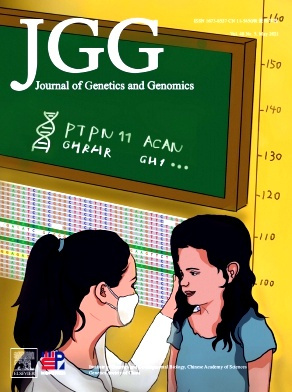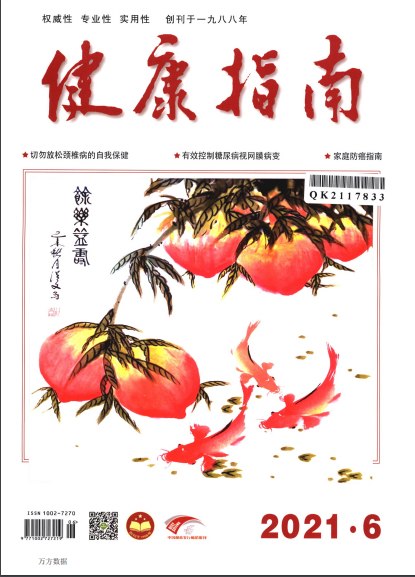
Journal of Genetics and Genomics詳細信息
Journal of Genetics and Genomics
Journal of Genetics and Genomics
Journal of Genetics and Genomics投稿要求
Journal of Genetics and Genomics雜志投稿須知:Title pageInclude the following information on this page:? Title The full manuscript title should be succinct, informative and descriptive. The title should include detail for indexing and should be comprehensible for a broad scientific audience. Authors should avoid using nonstandard abbreviations in titles. The title must mention the subject organism (or general group in the case of comparative work). Latin names should be used for all organisms, while common names are allowed for the model systems (rice, maize and yeast).? Author affiliation Include department, institution, and complete address for each author. If there are authors with different affiliations, use superscripts to match authors with different institutions. ? Corresponding author The name, complete address, telephone and fax numbers, and e-mail address of the corresponding author should be provided. ? Manuscript information The numbers of text pages (including references and figure legends), of figures, of tables, and of words in the paper should be provided.? Word and character counts The number of words in the abstract and the total number of characters in the paper should be provided. ? Abbreviation footnote List abbreviations in alphabetical order used five or more times . Define these where first mentioned in the text and do not use them in the title.Abstract and keywords The abstract should stand on its own with no reference to the text. It should contain approximately 200 words and must summarize the questions being addressed, the approach taken, the major findings, and the significance of the results. It should be concise, complete, and clearly communicate the importance of the work for a broad audience. At least three key words (for the purposes of indexing) should be supplied following the abstract.TextAuthors should divide their manuscripts into the following sections: Introduction, Results, Discussion, and Materials and methods. Mark every section and every subsection with serial number, like
1、, 。
2、, 。
3、, and then 1、1、, 1、2、, 1、3 and so on.? Introduction The Introduction should provide the necessary background information for the average reader; it should be both complete and concise. Previous publications that form a basis for the work presented must be cited. Citation of reviews is not a substitute for citing primary research articles. Citation of recent research articles is not a substitute for citing original discoveries. An author’s own work should not be cited preferentially over equally relevant work of others. ? Results The Results should be organized using subheadings to make clear.? Discussion The Discussion should focus on the interpretation rather than a repetition of the Results section. ? Materials and Methods Methods must be described completely enough so that other laboratories can replicate results and verify claims. Generally, standard procedures should be referenced, though significant variations should be described. Appropriate experimental design and statistical methods should be applied and described wherever necessary for proper interpretation of data and verification of claims. All novel materials and the procedures should be described in sufficient detail to allow their reproduction.AcknowledgementsList dedications, acknowledgements and funding support.References Cite references in the text by name and date of publication, but not by number. Authors are expected to proofread every citation in their reference list against the PDF or photocopy of the cited work so that the reference list is accurate with respect to spellings, symbols, italics, and subscripts/superscripts. Only published or in-press papers and books may be cited in the reference list. Citations for web sites (other than for primary literature) should be handled parenthetically in the text and not included in the reference list. Authors should test all URLs and links.It is expected that all cited publications have been read and determined to be appropriate by the authors, not merely identified by database searches. Reference to specific results should be to original research articles, not to more recent articles or reviews.A reference manager software, Endnote, Reference Manager or other similar software, is suggested to be used. Then spelling errors and fault information can be avoided. The reference format is the same as Developmental Biology.
Journal of Genetics and Genomics統(tǒng)計分析
影響因子:指該期刊近兩年文獻的平均被引用率,即該期刊前兩年論文在評價當(dāng)年每篇論文被引用的平均次數(shù)
被引半衰期:衡量期刊老化速度快慢的一種指標(biāo),指某一期刊論文在某年被引用的全部次數(shù)中,較新的一半被引論文刊載的時間跨度
他引率:期刊被他刊引用的次數(shù)占該刊總被引次數(shù)的比例用以測度某期刊學(xué)術(shù)交流的廣度、專業(yè)面的寬窄以及學(xué)科的交叉程度
引用半衰期:指某種期刊在某年中所引用的全部參考文獻中較新的一半是在最近多少年時段內(nèi)刊載的
平均引文數(shù):在給定的時間內(nèi),期刊篇均參考文獻量,用以測度期刊的平均引文水平,考察期刊吸收信息的能力以及科學(xué)交流程度的高低
熱門評論
心儀了很久都沒下手,終于搞活動了,毫不猶豫就買的,很劃算,很滿意哈,Journal of Genetics and Genomics很不錯哈,是正版哈,還沒拆開,下次再來哈。
從投稿到錄用大概30天的樣子,其中有一篇還經(jīng)歷了今的國慶節(jié)。總的感覺是很順。編輯部很負責(zé),超級敬業(yè),郵件回復(fù)速度快,非常建議大家投稿!!!
Journal of Genetics and Genomics雜志審稿人給出的意見雖然比較基礎(chǔ)、專業(yè),回答起來還是比較容易。感覺這個雜志要求還是很高的,只要做的東西有新意,接受的概率還是挺大。望雜志越辦越好!
Journal of Genetics and Genomics比較注重文章的創(chuàng)新點和理論實際的結(jié)合。他們的投稿要求一定要認(rèn)真看,寫的非常詳細,簡直就是導(dǎo)師了。然后在他們網(wǎng)站上看看之前收錄的文章,就知道該怎么寫、寫什么內(nèi)容了。這樣就比較容易中啦。
去國慶前一個禮拜投的,國慶期間就收到了編輯部發(fā)來的退修通知,當(dāng)時的心情很是激動,然后就認(rèn)真修改,編輯部的人態(tài)度依然特別的好,返修后,大概不到一個月的時間復(fù)審結(jié)束,終審2天修改了稿件格式,之后錄用,Journal of Genetics and Genomics雜志真贊,Journal of Genetics and Genomics雜志的工作人員效率真心高,謝謝Journal of Genetics and Genomics雜志,謝謝編輯及所有Journal of Genetics and Genomics雜志的工作人員!
這是本人的第一篇Journal of Genetics and Genomics文章,開心之余也有點小遺憾,如果當(dāng)時靜下心來深入分析,會有更好的結(jié)果。感謝尊敬的導(dǎo)師和可愛的師兄弟們。希望自己后面可以靜下心來,更深入的做研究,沖擊更高水平期刊。
8月底投稿,9月開始外審,9月19號回來一個,9月24號回來一個,兩個意見都是修改后錄用,但是給的終審意見是修改后再審,不過修改提交后,立刻就有結(jié)果說錄用了。
投稿之后,編輯部能及時提供反饋信息。編輯傳遞修改信息給作者非常清晰,只需要按照其要求修改即可。
很快送外審,外審專家提了一些意見。這次投稿過程順路且迅速,自己也沒想到效率這么高,不過見刊就要長點時間了,Journal of Genetics and Genomics編輯老師挺好,有疑問可以打電話給編輯老師。
目前期刊接受率還挺高。Journal of Genetics and Genomics雜志的工作效率還是不錯的,正常情況都能在規(guī)范時間內(nèi)完成所有程序。審稿人都比較專業(yè),水平還是有的,針對論文提的問題很到位,編輯也比較耐心。非常不錯的期刊
相關(guān)問題
- Journal of Genetics and Genomics是正規(guī)期刊嗎?
- Journal of Genetics and Genomics是什么級別的期刊?是核心期刊嗎?
- Journal of Genetics and Genomics評職稱可以嗎?單位認(rèn)可嗎?
- Journal of Genetics and Genomics是北大核心嗎?是中文核心嗎?
- Journal of Genetics and Genomics是科技核心嗎?
- Journal of Genetics and Genomics是統(tǒng)計源核心嗎?
- Journal of Genetics and Genomics是南大核心CSSCI嗎?
- Journal of Genetics and Genomics是CSCD期刊嗎?
- Journal of Genetics and Genomics是國家級期刊嗎?
- Journal of Genetics and Genomics是SCD期刊嗎?
- Journal of Genetics and Genomics是國家新聞出版署第一批、第二批學(xué)術(shù)期刊嗎?
- Journal of Genetics and Genomics好投嗎?Journal of Genetics and Genomics簡介
相關(guān)期刊
更多常見問題
| Q:論文發(fā)表的時候可以一稿多投嗎? |
| A:一稿多投的行為是典型的學(xué)術(shù)不端的行為,是國內(nèi)外學(xué)術(shù)界都明令禁止的行為,原因主要在于涉及到文章版權(quán)歸屬的問題,如果作者的文章已經(jīng)被某個雜志社錄用,或者同時被兩家雜志社錄用,就會涉及到版權(quán)糾紛,作為雜志社都會保護本社的合法權(quán)益,到這時作者就會比較麻煩,吃官司都是小事兒了,被打入黑名單降級降職影響可就太大了。 |
| Q:職稱論文發(fā)表對時間有限制嗎? |
| A:職稱論文發(fā)表并沒有明確規(guī)定截止時間,需要作者結(jié)合自己所在地區(qū)的具體規(guī)定自己安排發(fā)表時間,一般職稱評審,各地區(qū)都會明確規(guī)定申報材料的最后期限和截止日期,我們結(jié)合這個日期來考慮何時發(fā)表文章就可以,大部分地區(qū)職稱評審都集中在每年的8-10月之間,有的地區(qū)要求7月中旬開始交材料,最晚8月底之前,有的則是要求8月中旬交,還有部分地區(qū)要求截止時間為申報時間上年的12月31日,所以,各個地區(qū)的具體要求并不同,申報者需要在提交材料前確保自己的文章已經(jīng)見刊并且被相應(yīng)的數(shù)據(jù)庫檢索即可。 |
| Q:網(wǎng)上發(fā)表論文如何防騙?可靠網(wǎng)站與可疑網(wǎng)站如何區(qū)分? |
| A:由于發(fā)表論文的需求遠遠多于雜志版面的供應(yīng),再加上眾所周知的審稿難!審稿慢!選擇論文發(fā)表網(wǎng)站發(fā)表表論文確實能解決以上問題。賣方市場的出現(xiàn)加之發(fā)表論文的剛性需求,就導(dǎo)致出現(xiàn)先付款后發(fā)表的現(xiàn)狀。論文發(fā)表網(wǎng)站正規(guī)與否是通過網(wǎng)站從始至終所提供服務(wù)體現(xiàn)出來的,任何交易只要存在時間差都會有風(fēng)險,但這個風(fēng)險是可以通過您的智慧來避免的。因為不是所有論文網(wǎng)站都是騙子,你要做的就是過濾掉沒保障的網(wǎng)站,選擇可靠的論文發(fā)表網(wǎng)站! |
| Q:一般期刊需要提前多久準(zhǔn)備? |
| A:省級、國家級期刊建議至少提前6個月準(zhǔn)備。一般來講,雜志社為了確保每期雜志正常出刊,都會提前將當(dāng)期之后1-3個月的稿件提前安排好,而一些創(chuàng)刊較早,認(rèn)可度更高的熱門期刊,來稿量較大,發(fā)表周期可能就會更久。提前準(zhǔn)備,意味著雜志的可選擇性更多。 |
| Q:核心期刊需要提前多久準(zhǔn)備? |
| A:核心期刊建議至少提前12個月準(zhǔn)備,核心期刊正常的審稿周期為1-3個月,且審核嚴(yán)格,退稿、返修幾率更大,這意味著在流程上耗費的時間更久,且核心期刊版面有限,投稿競爭更加激烈,即使被錄用,排刊也比普通期刊晚很多,因此需要更早準(zhǔn)備。 |

代護理.jpg)
藥衛(wèi)生.jpg)
學(xué).jpg)
學(xué)信息導(dǎo)報.jpg)
學(xué)美容.jpg)
于我們.jpeg)